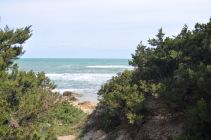you are in:
News
The two main factors that contribute to the formation of the dunes are the action of wind and psammophites vegetation: the former determines the accumulation of sand, the latter allows with its roots, its consolidation. At the end of the evolutionary cycle of these mounds of sand there are fossil dunes, the result of phenomena already fully completed in time. They have an age of hundreds of thousands years and are therefore important for understanding the development of the ecosystem. From the beach to the dune, there are different habitats that coexist.
In the part of the beach less reached by the waves, where organic debris can be deposited, we can find the Embryo dunes (Cakileto), the plant community which is the first "outpost" of the coastal ecosystem. In fact, all the species that characterize it hinder the mobility of the sand by large root systems. This habitat is severely threatened by excessive human settlement of the beaches: the creation of gates for the access to the sea, parking lots too close to the dunes, the mechanical cleaning of the beaches compromises their process of settlement.
Going inland we observe the embryonic stages of the dune, which begins to form due to the presence of vegetation that makes up the agropyron land, the species which contribute to the consolidation of the heaps of sand. The beaches of Bermuda grass - the guidance species of this community - with its creeping rhizomes harnesses, holds the loose sands, thereby playing a building function.
In some limited sections of the areas behind the dunes, on partially inconsistent and slightly sloping sands, there are small meadows of annuals dominated by whitish plantain - another species that contribute to the consolidation of the coastal sands - which prepares the ground for the colonization of garrigue species. Although in good conditions, just like the rest of the vegetation that characterizes the marine deposit lines, this habitat was affected by the threat of gates for the access to the sea baths and, due to its inherent fragility, it is inappropriate to use this grass fields as a staging and transit areas. The dune with sclerophyll vegetation alternates with juniper dune vegetation (juniper scrub is characterized by two species, Juniper oxicedro and the Phoenician juniper), with a prevalence of common phillyrea, mastic and our local sarsaparilla (known as "stracciabraghe” – pants shredder), followed by mastic and myrtle bushes. Next to the juniper, other species of the maquis shrubland grow, such as the holm and the Mediterranean prasium.
Newsletter
Park Authority



























